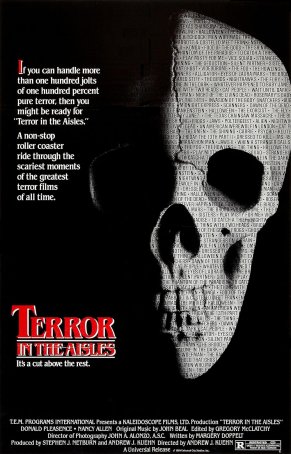
Terror in the Aisles is a clip-fest. With excerpts
from nearly 80 horror movies that run the gamut from classics to long-forgotten
duds, the film provides glimpses of cinematic scares and gore covering the
period between the 1930s and the early 1980s. With an emphasis on the then-new
slasher genre and its best-known representatives (particularly Halloween
and its sequel, Friday the 13th and its sequel, and The
Texas Chainsaw Massacre), the film offers an unexpurgated (none of the
R-rated material is censored for violence, gore, or nudity) trip down memory
lane. Although largely made obsolete by YouTube, this was a surprisingly
popular theatrical release around Halloween 1984 and was frequently rented when
it appeared on VHS the following year.
Unlike many similar movies (almost all of which were either
direct-to-video or direct-to-cable), this one doesn’t attempt to provide any
deep philosophizing about why horror movies are popular. (The closest it gets
is when narrator Donald Pleasence intones: “We all carry around a certain
amount of resentment and rage, because we can’t let it out. In the movies, we
can.”) It also doesn’t provide a lengthy chronology of horror in the cinema,
preferring to group the clips by category rather than year of release.
Interestingly, Terror in the Aisles never calls any of its titles a
“horror movie,” preferring instead the terms “terror movie” or “scary movie.”
I’m unsure of the movie’s budget but it had to be at least
several million dollars even though 90% of this was the work of others. In
addition to paying for the rights to show clips from films not owned by
distributor Universal Pictures, actors Donald Pleasence and Nancy Allen were
recruited for roles as tongue-in-cheek hosts. Hunkered down in a movie theater
alongside other patrons watching moments of horror unfold on-screen, they
provide minimalist commentary. Most of what they have to say is unmemorable,
but their dialogue isn’t the point.
The list of clips found in Terror in the Aisles is
quite extensive and incorporates not only snippets from some of the classic
Universal monster movies (Frankenstein, The Bride of Frankenstein, and The
Wolfman) but excerpts from various Alfred Hitchcock titles (notably Strangers
on a Train, Psycho, and The Birds) as well as material from Jaws and
Jaws 2. Other select movies samples include Creature from the Black
Lagoon, Konga, The Fly, Whatever Happened to Baby Jane?, The Omen, Carrie,
Rosemary’s Baby, Wait Until Dark, Night of the Living Dead, Dawn of the Dead,
Play Misty for Me, The Thing, The Exorcist, Midnight Express, The Deer Hunter,
Alien, Invasion of the Body Snatchers, The Fog, When a Stranger Calls, The Shining, The Howling, Dressed to Kill, Vice Squad, Cat People, Poltergeist,
Videodrome, Firestarter, Marathon Man, and dozens of
others.
Terror in the Aisles should not be considered
definitive. Two notable absences are kaiju films (although there is a short
clip from King Kong vs. Godzilla) and vampire movies. Although one could
explain away the first as a rights-issue problem, it’s difficult to make the
same argument for the bloodsucking brood since Lugosi’s Dracula was a
Universal film (as was the popular 1979 version starring Frank Langella). I
guess vampires were on the outs in 1984. We are treated to werewolves however.
There’s a sequence in which the transformation scenes from The Wolfman
and An American Werewolf in London are compared – it’s instructive to
see how much things had changed in 40 years.
Viewed by today’s audiences, what Terror in the Aisles offers
may appear quaint, outdated, and incomplete. Its 1984 release date means that
many of the most popular horror film franchises (A Nightmare on Elm Street,
for example) weren’t available at the time. And, although the linking scenes
with Allen and Pleasence represents “new material,” it’s neither abundant nor
insightful. In 1984, however, this offered a 90-minute nostalgia binge on par
with no other. With no Internet and with VCRs still having minimal household
penetration, a clip show like this provided viewers a chance to see their
horror memories projected onto a big screen. In the 21st century,
this is a throw-away but what it offered at the time of its release was
substantial.

Terror in the Aisles (United States, 1984)